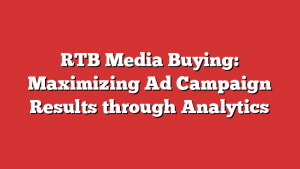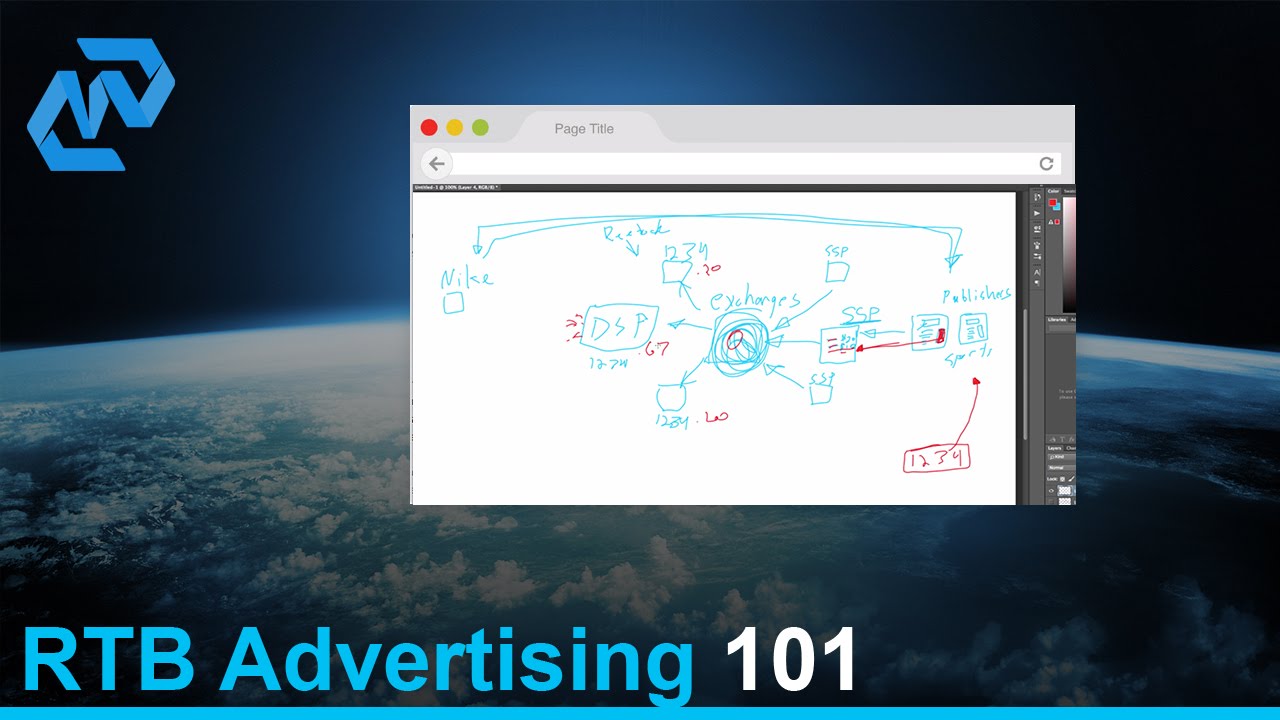In the fast-paced world of digital advertising, every second counts.
And in the realm of RTB media buying, those precious seconds can make all the difference.
RTB, or real-time bidding, offers advertisers a revolutionary way to connect with their target audience.
By harnessing advanced algorithms and cutting-edge technology, advertisers can now bid on publisher inventory in real-time, placing their tailored ads in front of the right users at the right time.
But that’s just the tip of the iceberg.
RTB media buying opens up a world of possibilities, with its unrivaled ability to optimize campaign performance and tap into a wider selection of inventory.
In this article, we will delve into the fascinating world of RTB media buying and uncover why it has become the go-to strategy for forward-thinking advertisers.
So grab a seat, buckle up, and prepare to be blown away by the power of RTB media buying.
Table of Contents
rtb media buying
RTB media buying refers to the process of buying and selling digital ad inventory in real-time through an instant auction.
This method is part of programmatic advertising, which leverages technologies like AI and machine learning.
RTB allows multiple advertisers to bid on a single impression of a publisher’s inventory, with the highest bidder winning and having their ad served to the user.
It offers benefits such as streamlined buying, optimized campaigns, wider inventory selection, increased transparency, added flexibility, and optimized bidding.
RTB transactions happen quickly, with billions of auctions processed daily.
While RTB is a significant part of programmatic advertising, it is not the only method, as publishers can also sell inventory throughprogrammatic guaranteed or direct methods.
Overall, RTB media buying offers a more efficient and targeted approach for advertisers and provides insight into ad placements for publishers.
Key Points:
- RTB media buying involves the buying and selling of digital ad inventory through instant auctions.
- It is a part of programmatic advertising that utilizes AI and machine learning technologies.
- Multiple advertisers can bid on a publisher’s inventory, with the highest bidder getting their ad served to the user.
- Benefits of RTB include:
- Streamlined buying
- Optimized campaigns
- Wider inventory selection
- Increased transparency
- Added flexibility
- Optimized bidding
- RTB transactions happen quickly, with billions of auctions processed daily.
- RTB is not the only method of programmatic advertising, as publishers can also sell inventory through programmatic guaranteed or direct methods.
Check this out:
💡 Did You Know?
1. Before the advent of programmatic advertising, media buying involved placing ads manually by negotiating rates with publishers and purchasing ad space directly.
2. RTB stands for “Real-Time Bidding,” referring to the automated process of buying and selling digital ad impressions in real-time auctions.
3. Media buying agencies can use data and analytics to identify the most effective ad placements, target specific demographics, and optimize campaigns for better performance.
4. The first online ad was a simple banner ad that appeared on HotWired.com in 1994, with a 44% click-through rate. This marked the beginning of a new era in digital media buying.
5. RTB media buying allows advertisers to bid on ad impressions individually, enabling them to display their ads to specific audiences at the right time, improving ad relevance and ROI.
What Is Rtb Media Buying?
Real-time bidding (RTB) media buying is a digital advertising process that allows multiple advertisers to bid on a single impression of a publisher’s inventory. This automated auction-based system revolutionized the way ad space is bought and sold, making it more efficient and targeted.
In traditional advertising, advertisers would negotiate with publishers to secure ad space based on demographics, placement, and other factors. However, with RTB media buying, the process is much more streamlined. Advertisers now have the ability to target specific audiences and only bid on impressions that align with their target demographic, leading to better return on investment (ROI) and higher effective cost per thousand impressions (eCPMs).
The beauty of RTB media buying lies in its real-time nature. Advertisers can participate in auctions and place bids on millions of ad impressions in the blink of an eye. Through advanced algorithms and technology, the winning ad with the highest bid is instantly served to the user, creating a seamless and tailored user experience.
How Rtb Determines The Winning Ad
In the RTB media buying process, the winning ad is determined based on the highest bid. When a user visits a publisher’s website or app, a bid request is sent to an ad exchange. This bid request contains information about the user, such as their demographics, browsing history, and behavior.
Advertisers, armed with this information, bid in real-time for the ad impression. Each advertiser submits their bid, which is typically the maximum amount they are willing to pay for that particular impression. The auction happens almost instantaneously, and the ad exchange selects the highest bid as the winner.
The winning ad, belonging to the advertiser with the highest bid, is then served to the user on the publisher’s website or app. This process ensures that the user sees the most relevant and engaging ad, while also maximizing revenue for the publisher.
Benefits Of Rtb For Advertisers
RTB media buying offers several benefits for advertisers. Firstly, it allows for efficient buying, as advertisers can pinpoint their target audience and only bid on impressions that align with their marketing objectives. This level of precision targeting eliminates wasteful spending and ensures that ad budgets are used effectively.
Additionally, RTB enables advertisers to fine-tune their user targeting. By analyzing user data and behavior, advertisers can optimize their campaigns and deliver personalized messages to their intended audience. This level of customization increases the chances of attracting and engaging users, ultimately driving higher conversion rates.
RTB also offers increased transparency in the advertising process. Advertisers have insights into the ad placements, allowing them to monitor performance, make data-driven decisions, and adjust strategies in real-time. This transparency fosters a greater level of control and accountability, as advertisers can see the exact return on investment for each impression.
Furthermore, RTB expands the pool of media buyers, creating a more competitive environment. This competition drives up the value of ad impressions, leading to higher eCPMs for publishers. It also allows advertisers to have access to a wider range of inventory, ensuring that their ads are displayed in diverse and relevant contexts.
Overall, RTB media buying empowers advertisers to optimize their campaigns, maximize results, and achieve their advertising goals with precision and efficiency.
FAQ
What is RTB in media?
RTB, or real-time bidding, is a dynamic process that facilitates the buying and selling of digital advertising inventory. Taking place in a fraction of a second, RTB allows advertisers to evaluate and place bids on each available impression on platforms like Authorized Buyers. This real-time approach enables advertisers to make well-informed, instantaneous decisions based on the specific characteristics of each impression, ultimately optimizing the effectiveness and efficiency of their campaigns. Through RTB, the digital advertising landscape becomes a speedily responsive and dynamic marketplace, maximizing the value and reach of ad inventory.
What does RTB stand for in marketing?
RTB in marketing stands for Real Time Bidding. This innovative practice facilitates the instantaneous buying and selling of digital advertisements through programmatic advertising. By leveraging RTB, marketers can optimize their ad campaigns by bidding and exchanging ads in real time, ensuring maximum efficiency and relevance. This approach empowers advertisers to reach their target audience with precision, while publishers can maximize their revenue by selling ad space to the highest bidder. RTB has revolutionized the world of marketing by bringing automation and efficiency to the process of buying and selling digital ads.
What is RTB and programmatic buying?
Real-time bidding (RTB) is a specific component of programmatic media buying that facilitates the buying and selling of ad inventory in real-time auctions. Unlike traditional ad buying methods, RTB allows advertisers to bid on individual ad impressions in real-time, targeting specific audiences and optimizing campaign performance. This dynamic approach enables advertisers to make instantaneous decisions and deliver personalized ads to consumers, leading to more effective and efficient ad campaigns.
On the other hand, programmatic buying refers to the overall process of automating ad buying and selling using software and algorithms. It encompasses various methods, such as RTB, private marketplaces, and automated guaranteed, to optimize media buying efficiency, targeting accuracy, and overall campaign impact. Programmatic buying allows advertisers to have greater control and precision in reaching their desired audience, leveraging data and technology to deliver the right message to the right person at the right time. It revolutionizes the ad industry by streamlining the buying process and enhancing campaign performance through data-driven decision-making.
What is the difference between ad exchange and RTB?
While an ad exchange refers to a specific actor in the programmatic ecosystem, RTB represents the process in which actors engage in real-time bidding for ad placements. The ad exchange acts as a platform that facilitates the buying and selling of digital ad inventory, where publishers make their inventory available and advertisers purchase it. On the other hand, RTB focuses on the live bidding process, where advertisers compete in real time to win the opportunity to display their ads on publishers’ websites. Thus, while ad exchanges are a part of the programmatic ecosystem, RTB is the dynamic process within it that determines which ad placements are ultimately sold and displayed.












